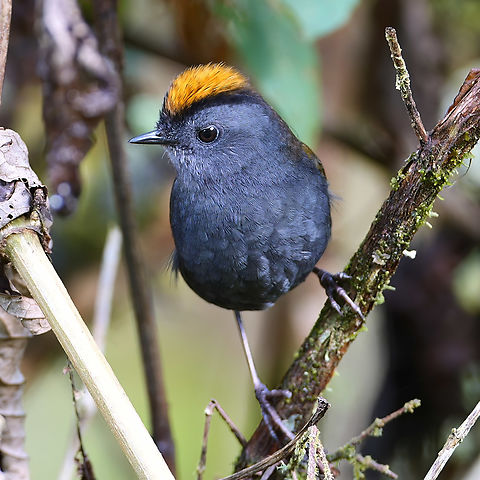
Appearance
The wrenthrush is 10 to 11.5 cm long and weighs about 21 g. It is short-tailed and rather plump, with a short thin bill somewhat like that of a Parulidae warbler. The sexes are alike. Adults have a large yellow-orange patch with black borders on their crown. Their face and the sides of their neck are leaden gray. Their upperparts, tail, and flanks are dull olive bronze. Their underparts are leaden gray with an olive tinge to the undertail coverts. Juveniles do not have the orange crown and their upperparts are more brownish than those of adults.Distribution
The wrenthrush is found from the Cordillera de Guanacaste in northern Costa Rica discontinuously through that country into western Panama's Chiriquí and Veraguas provinces.Status
The IUCN has assessed the wrenthrush as being of Least Concern. It has a small range and its population size is unknown but believed to be stable. No immeditate threats have been identified. "[H]abitat degradation and destruction could become a concern" but "its specialized high-altitude habitat seems not to be presently under threat".Habitat
It inhabits montane evergreen forest and elfin forest, landscapes characterized by constant wetness and fog. It particularly favors dense vegetation near streams, including stands of "Chusquea" bamboo. In elevation it ranges from about 1,500 m up to treeline; in Costa Rica it mostly occurs around 2,500 m.Reproduction
The wrenthrush's breeding season appears to span from March to early July. Few nests have been found. They were domes made of moss, twigs, and leaves with a side entrance and a lining of dried leaves, grass, and moss. They were placed in cavities in earthen banks and were partially hidden by overhanging vegetation. The clutch size in three nests was three eggs. The incubation period is not known; the time from hatch to fledging appears to be at least 18 days. Both parents provision the nestlings.Food
The wrenthrush forages by hopping among branches and along the ground searching for arthropods, especially spiders and Lepidoptera larvae. It mostly forages in dense vegetation, though it occasionally works the edges of it and also hunts as high as 10 m above the ground in vines and epiphytes.References:
Some text fragments are auto parsed from Wikipedia.